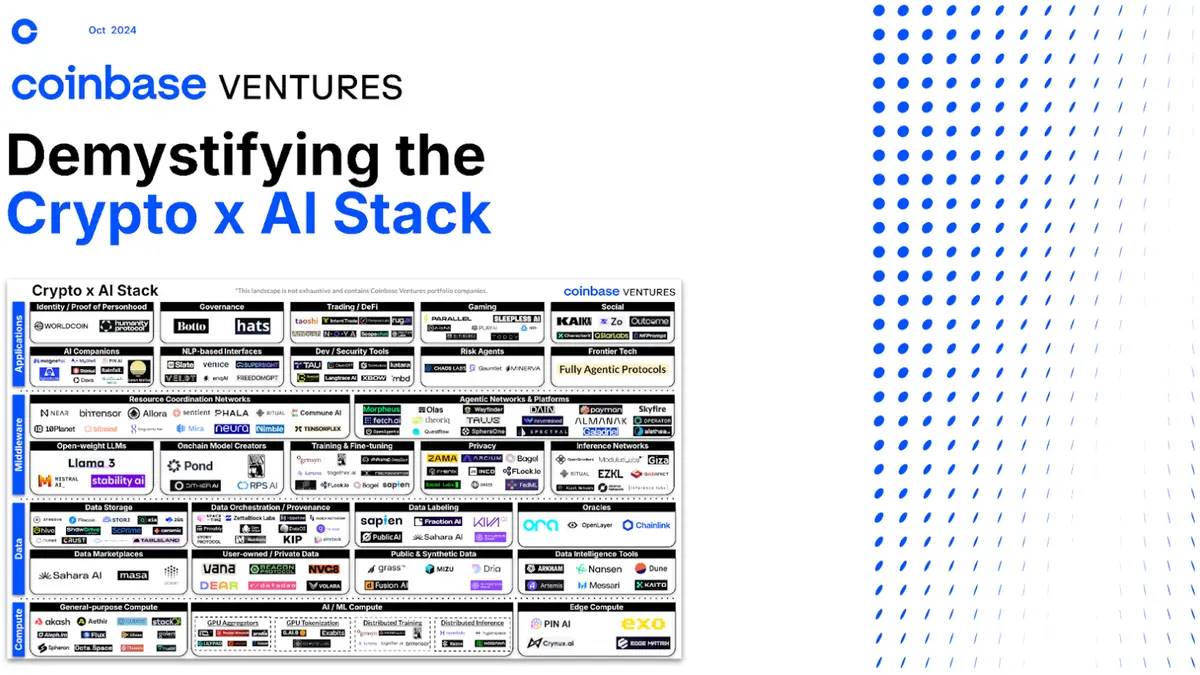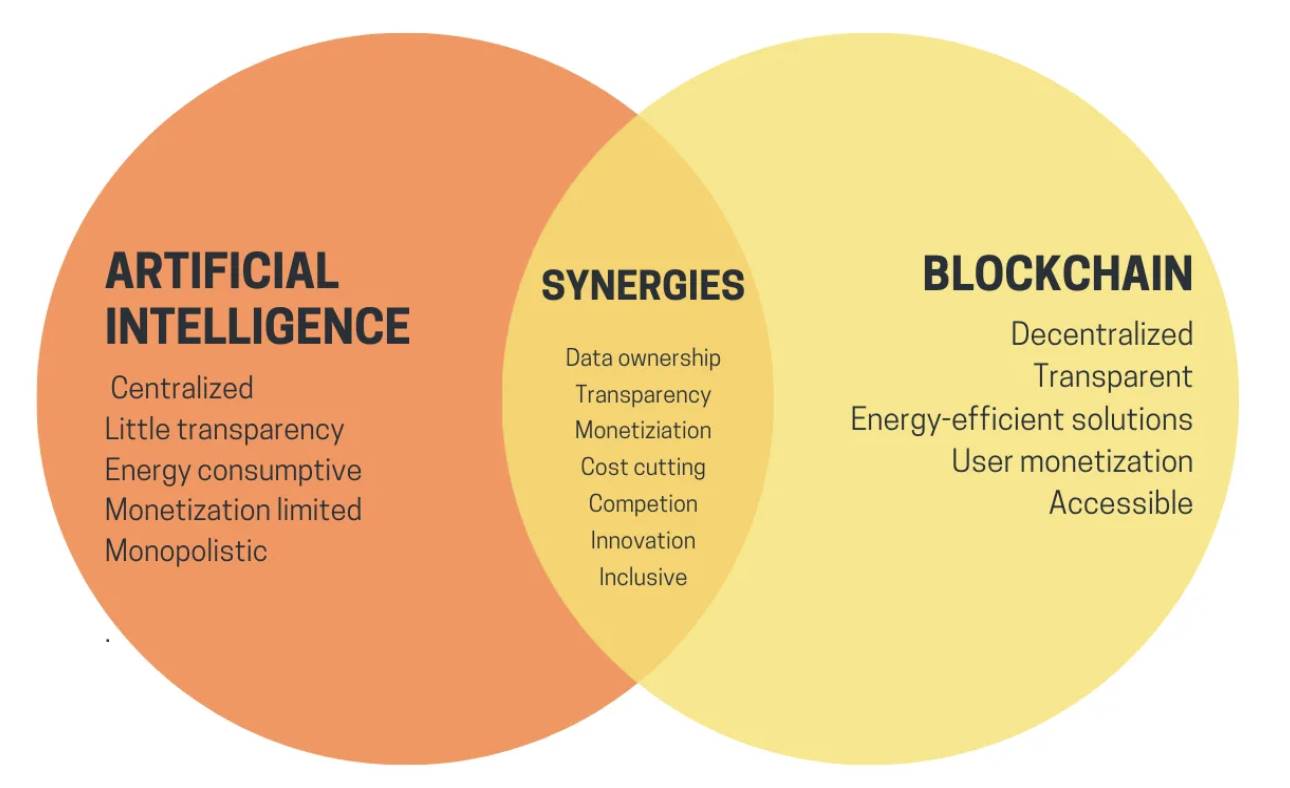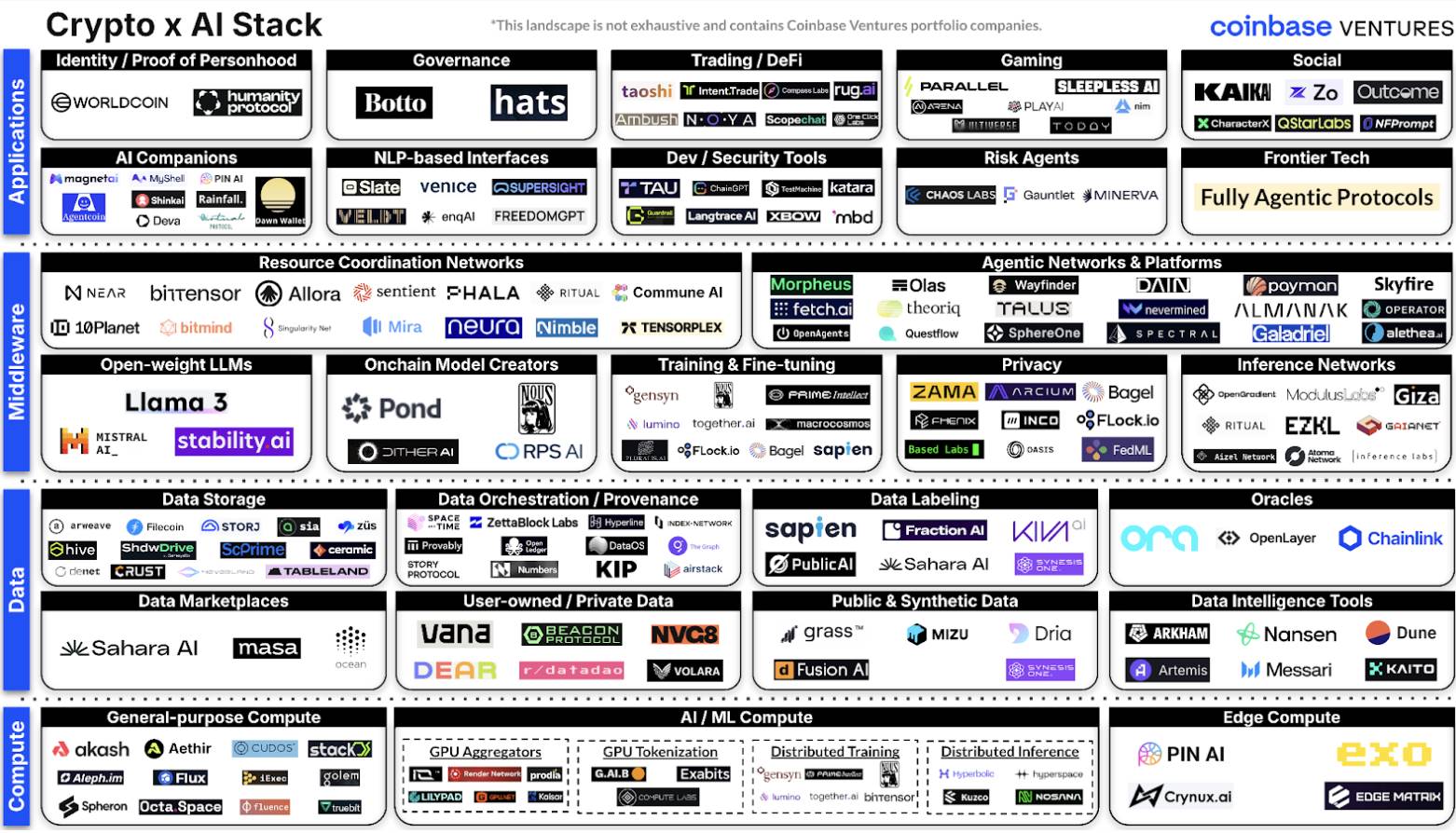Decentralized AI infrastructure, advancements in on-chain AI applications, and the emergence of the "Agentic Web" will bring significant developments.
Author: Jonathan King
Translation: Deep Tide TechFlow

Summary: The future of artificial intelligence can develop based on blockchain technology, as cryptographic technology can enhance the accessibility, transparency, and application scenarios of emerging technologies. The efficiency, borderless nature, and programmability of cryptographic technology combined with AI may change the way humans interact with machines in the digital economy, allowing users to take control of their personal data. This also includes the rise of the "Agentic Web," where AI agents running on cryptographic infrastructure can drive economic activity and growth.

Disclosure and Footnotes: Portfolio companies of Coinbase Ventures will be marked with an asterisk (*) when mentioned for the first time in the text.
So what does this look like? AI agents trading on cryptographic infrastructure. Software code created by AI, including smart contracts, drives a surge in on-chain applications and experiences. Users can own, manage, and benefit from the AI models they participate in. Utilizing AI to enhance user and developer experiences in the crypto ecosystem, augment the functionality of smart contracts, and create new application scenarios presents even more possibilities.
As we envision this future of the fusion of crypto and AI, today we are releasing our core perspectives on this transformative technological integration. Overview:
We believe that cryptographic/blockchain technology is not a necessity for advancing every layer of the AI technology stack or addressing emerging challenges. Instead, cryptographic technology can play a significant role in providing AI with more distribution, verification, censorship resistance, and native payment channels while leveraging AI mechanisms to drive new user experiences on-chain.
The combination of crypto and AI can give rise to the "Agentic Web," a transformative model where AI agents running on cryptographic infrastructure can become significant drivers of economic activity and growth. We predict that in the future, agents will have their own crypto wallets, autonomously conduct transactions and realize user intentions, access low-cost decentralized computing and data resources, or use stablecoins to pay humans and other agents to complete tasks necessary for their overall goals.
Preliminary beliefs supporting this argument include: (1) cryptocurrencies will become the preferred payment method for agents to conduct commercial transactions with humans and between agents, (2) generative AI and natural language interfaces will become the primary means for users to conduct on-chain transactions, (3) AI will create most of the software code (including smart contracts), triggering a "Cambrian explosion" of on-chain applications and experiences.
The integration of crypto and AI can be divided into two core sub-parts: (1) Decentralized AI (Crypto -> AI), which involves building a general AI infrastructure that possesses the characteristics of modern peer-to-peer blockchain networks, (2) On-chain AI (AI -> Crypto), which involves building infrastructure and applications that utilize AI to support new and existing application scenarios.
The ecosystem of crypto and AI can be divided into the following layers: (1) Computing Layer (e.g., networks focused on providing potential graphics processing units (GPUs) for AI developers), (2) Data Layer (e.g., networks supporting decentralized access, coordination, and verification of AI data pipelines), (3) Middleware Layer (e.g., platforms supporting the development, deployment, and hosting of AI models/agents), (4) Application Layer (e.g., user-facing products utilizing on-chain AI mechanisms, whether B2B or B2C).
At Coinbase, our mission is to help update the financial system to make it more secure and reliable while enhancing accessibility and usability for consumers and developers. We believe that the combination of crypto and AI will play a significant role in this process. In this blog, we will delve into the significance, implementation, and future directions of the integration of crypto and AI.
Introduction to Crypto and AI
The AI market has experienced significant growth and investment in recent years, with venture capital firms investing nearly $290 billion in this field over the past five years. The World Economic Forum points out that AI technology could boost the annual GDP growth of the United States by 0.5-1.5% over the next decade. AI applications have shown strong appeal, with applications like ChatGPT4 setting new records for user growth and adoption. However, with the rapid development of the AI market, several challenges have also emerged, including data privacy issues, demand for AI talent, ethical considerations, centralization risks, and the rise of deepfake technology. These challenges have prompted attention to the integration of crypto and AI, as stakeholders seek solutions that leverage the advantages of both technologies to address these emerging issues.

Figure: Crypto and AI chart from Vitalik Buterin's blog
The combination of crypto and AI, merging the decentralized infrastructure of blockchain with AI's ability to mimic human cognitive functions and learn from data, creates a synergistic effect that could disrupt multiple industries. Blockchain redefines system architecture, data, and transaction verification and distribution, while AI enhances data computation and analysis capabilities and provides new ways to generate content. This combination has sparked both excitement and skepticism among developers in both technology communities, driving exploration of new application scenarios that could accelerate the adoption of both fields in the long term. Although crypto and AI are broad terms encompassing various technologies and topics, we believe their integration can be divided into two core subfields:
Decentralized AI (Crypto -> AI) enhances AI capabilities through cryptographic permissionless and composable infrastructure. This enables applications such as democratized access to AI resources (e.g., computing, storage, bandwidth, training data, etc.), collaborative open-source model development, verifiable reasoning, or ensuring the provenance and authenticity of content through immutable ledgers and cryptographic signatures.
On-chain AI (AI -> Crypto) brings the advantages of AI into the crypto ecosystem, enhancing user and developer experiences through large language models and natural language interfaces, or augmenting the functionality of smart contracts. Applications of on-chain AI have two pathways: (1) developers integrating AI models or agents into their smart contracts and on-chain applications, and (2) AI agents utilizing cryptographic channels (e.g., self-hosted wallets, stablecoins, etc.) for payments and accessing decentralized infrastructure resources.
While the fields of "crypto in AI" or "AI in crypto" are still in their infancy, their potential is immense, especially against the backdrop of continuously improving computational infrastructure and intelligent speed, which is expected to unlock a range of yet-to-be-imagined application scenarios.
Crypto and AI: Unlocking the Key to the "Agentic Network"
We believe that a particularly exciting area of the integration of crypto and AI is the concept of AI agents operating on cryptographic infrastructure. This combination aims to create an "Agentic Network," a transformative model capable of enhancing security, efficiency, and collaboration in an AI-driven economy, supported by powerful incentive mechanisms and cryptographic technology.
We believe that AI agents will become significant drivers of economic activity and growth, gradually replacing humans as the primary "users" of applications (whether on-chain or off-chain). This paradigm shift will force many internet companies to rethink their fundamental assumptions about the future and provide corresponding products, services, and business models to best serve an agent-centric economy. However, we do not believe that encryption or blockchain technology is necessary at every layer of AI technology to enhance capabilities or address emerging challenges. Instead, cryptographic technology can play an important role in providing AI with more distribution, verifiability, censorship resistance, and native payment channels while leveraging AI technology to create new user experiences on-chain.
Our preliminary beliefs supporting this argument are as follows:
Cryptocurrencies will become the preferred payment method for agents to conduct commercial transactions with humans and other agents: As internet-native programmable money, cryptocurrencies have significant advantages in driving an agent-based economy. As AI agents become more autonomous and engage in large-scale microtransactions (such as payments for reasoning, data, API access, decentralized computing, or data resources), the efficiency, borderless nature, and programmability of cryptocurrencies make them a more popular medium of exchange than traditional fiat currencies. Additionally, agents require unique and verifiable identities (i.e., “Know Your Agent”) to ensure compliance with regulatory rules and requirements when transacting with businesses and end users. Low-fee blockchains, smart contracts, self-custody wallets (such as Coinbase AI Wallets), and stablecoins can simplify and reduce the costs of complex financial agreements between agents, while the verifiability and immutability of decentralized networks ensure trust and auditability in AI agent transactions.
Generative AI and natural language interfaces will become the primary means for users to conduct on-chain transactions: With improvements in natural language processing speed and AI's understanding of the crypto context, interacting on-chain through conversational interfaces will become the default behavior and expectation for users, aligning with current web2 trends (such as ChatGPT). Users will simply express their transaction intentions in natural language (e.g., “swap X for Y”), and AI agents will convert these intentions into verifiable smart contract code, providing the most efficient and cost-effective transaction execution path.
AI will generate most of the software code (including smart contracts), triggering a "Cambrian explosion" of on-chain applications and experiences: The code generation capabilities of AI in web2 (e.g., Devin, Replit) are rapidly improving and fundamentally changing the software development paradigm. We believe this shift will soon become a hot topic in the crypto space, with a short-term focus on significantly lowering the entry barriers for new and existing developers. However, future developments will see AI "software agents" generating smart contracts and highly personalized applications in real-time based on user preferences, stored and verified on-chain.
These viewpoints indicate that the boundaries between AI and crypto will increasingly blur, creating a new paradigm of intelligent, autonomous, and decentralized systems. In this context, let’s delve deeper into the technology stack supporting Crypto x AI layer by layer.
Opportunities in the Crypto x AI Stack (Current Status)

The exploration of "integrating cryptographic technology into AI" or "integrating AI technology into crypto" has given rise to a rapidly evolving and complex emerging field, attracting numerous developers eager to seize market opportunities. We believe the current Crypto x AI space can be divided into the following layers: (1) Computing Layer (referring to networks focused on providing GPU resources for AI developers), (2) Data Layer (referring to networks supporting decentralized access, orchestration, and verification of AI data pipelines), (3) Middleware Layer (referring to platforms or networks supporting the development, deployment, and hosting of AI models or agents), and (4) Application Layer (referring to user-facing products utilizing on-chain AI mechanisms, whether B2B or B2C).
Computing

Training and inference execution of AI models require substantial GPU computing resources. As the complexity of AI models increases, the demand for computing resources continues to grow, leading to a shortage of advanced GPUs like those from Nvidia, longer wait times, and rising costs. To address these issues, decentralized computing networks are gradually becoming a viable solution:
Creating open markets where users can purchase, lease, and host physical GPUs
Establishing GPU aggregation platforms that allow anyone (such as Bitcoin miners) to contribute excess GPU computing power to execute AI tasks and earn rewards through tokens
Tokenizing physical GPUs, converting them into digital assets on-chain for financialization
Developing distributed GPU networks to support compute-intensive tasks (such as training and inference)
Building infrastructure that allows AI models to run on personal devices (similar to decentralized Apple Intelligence)
The goal of these solutions is to increase the supply and accessibility of GPU computing resources while offering very competitive prices. However, due to varying degrees of limitations among most participants in supporting advanced AI workloads, facing issues of GPU resource distribution, and in some cases, lacking development tools and stability guarantees comparable to centralized solutions, we believe these products are unlikely to see widespread adoption in the near to mid-term. Emerging fields and example projects developing in this area include:
General Computing: Decentralized computing markets providing GPU computing resources for various applications (e.g., Akash, Aethir)
AI / ML Computing: Decentralized computing networks providing GPU computing resources for specific services, such as GPU aggregators, distributed training and inference, GPU tokenization, etc. (e.g., io.net, Gensyn, Prime Intellect, Hyperbolic, Hyperspace)
Edge Computing: Device-side LLM computing and storage networks supporting personalized and contextual inference (e.g., PIN AI, Exo, Crynux.ai, Edge Matrix)
Data

To scale AI models, larger training datasets are needed, and large language models (LLMs) are currently being trained on trillions of words of human text. However, the publicly available human-generated data today is limited (according to Epoch AI, high-quality language and data sources may run out by 2024). This raises the question: Will the lack of training data become a major bottleneck in the development of AI models, leading to stagnation in performance growth? Therefore, we believe that crypto and AI companies focusing on data have the following opportunities to address these challenges:
Incentivizing users to share their private or proprietary data (e.g., “Data DAO”—on-chain entities where data contributors can gain economic benefits by contributing private data from social platforms while controlling the use and monetization of the data)
Developing tools to generate synthetic data from natural language prompts or incentivizing users to scrape data from public websites
Encouraging users to help preprocess datasets to train models and maintain data quality (e.g., data labeling and reinforcement learning through human feedback)
Establishing open data markets with multi-party participation, where anyone can be rewarded for data contributions.
These opportunities have given rise to many emerging companies we see today in the data layer. However, it is worth noting that traditional centralized enterprises in the AI model lifecycle already possess strong network effects and data compliance mechanisms valued by traditional businesses, which may leave little room for decentralized alternatives. Nevertheless, we believe that the data layer of decentralized AI still holds significant long-term potential in addressing the "data wall" challenge. Emerging projects developing in this field include:
Data Market: Decentralized data exchange protocols that help data providers and consumers share and trade data assets (e.g., Ocean Protocol, Masa, Sahara AI)
User-Owned/Private Data (including DataDAOs): Networks that incentivize the collection of proprietary datasets, including data personally owned by users (e.g., Vana*, NVG8)
Public and Synthetic Data: Platforms for scraping data from public websites or generating new datasets through natural language prompts (e.g., Dria, Mizu, Grass, Synesis One)
Data Intelligence Tools: Platforms and applications for querying, analyzing, visualizing, and providing on-chain data insights (e.g., Nansen, Dune, Arkham, Messari*)
Data Storage: File storage networks for long-term storage and archiving, as well as relational database networks for managing frequently accessed and updated structured data (e.g., Filecoin, Arweave, Ceramic, Tableland*)
Data Orchestration/Provenance: Platforms that optimize data processing for AI and data-intensive applications while ensuring the provenance and authenticity of AI-generated content (e.g., Space and Time, The Graph*, Story Protocol)
Data Annotation: Platforms that incentivize distributed human contributors to create high-quality training datasets, improving the reinforcement learning and fine-tuning mechanisms of AI models (e.g., Sapien, Kiva AI, Fraction.AI)
Oracles: Networks that use AI to provide verifiable off-chain data for on-chain smart contracts (e.g., Ora, OpenLayer, Chainlink)
Middleware

To fully realize the potential of open and decentralized AI model or agent ecosystems, new infrastructure must be established. Some high-potential areas that developers are exploring include:
Using open-weight large language models (LLMs) to support on-chain AI applications while developing foundational models that can quickly understand and process on-chain data
Providing distributed training solutions for large foundational models (e.g., those with over 100 billion parameters); although this is often seen as challenging due to technical complexity, recent breakthroughs from Nous Research, Bittensor, and Prime Intellect are changing this perception
Utilizing zero-knowledge or optimistic machine learning (zkML, opML), trusted execution environments (TEE), or fully homomorphic encryption (FHE) to achieve private and verifiable inference
Achieving open, collaborative AI model development through resource coordination networks, or building agent networks/platforms that leverage cryptographic infrastructure to enhance the potential of AI agents in on-chain and off-chain applications
While there has been some progress in building this infrastructure, production-ready on-chain LLMs and AI agents are still in the early stages. We expect that unless the underlying computing, data, and model infrastructure matures further, this situation will not change significantly in the short to mid-term. Nevertheless, we believe this field is very promising and will be a core focus of Coinbase Ventures' investment strategy, as the growth and demand for AI services will drive development in this area over the long term. Emerging fields and example projects in this layer include:
Open-Weight Large Language Models (LLMs): These AI models have publicly available weights that anyone can freely use, modify, and distribute (e.g., LLama3, Mistral, Stability AI)
On-Chain Model Creators: Networks and platforms for creating foundational LLMs suitable for on-chain scenarios (e.g., Pond*, Nous, RPS)
Training and Fine-Tuning: Networks and platforms providing on-chain incentives and verifiable training or fine-tuning mechanisms (e.g., Gensyn, Prime Intellect, Macrocosmos, Flock.io)
Privacy: Networks and platforms that use privacy-preserving mechanisms to develop, train, and infer AI models (e.g., Bagel Network, Arcium*, ZAMA)
Inference Networks: Networks that verify the correctness of AI model outputs through cryptographic techniques or proofs (e.g., OpenGradient*, Modulus Labs, Giza, Ritual)
Resource Coordination Networks: Networks that facilitate resource sharing, collaboration, and coordination in AI model development (e.g., Bittensor, Near*, Allora, Sentient)
Agent Networks and Platforms: Networks and platforms that assist in creating, deploying, and monetizing AI agents in on-chain and off-chain environments (e.g., Morpheus, Olas, Wayfinder, Payman, Skyfire)
Applications

In the cryptocurrency space, AI agents are gradually emerging. Early examples include Dawn Wallet, a crypto wallet that utilizes AI agents to send transactions and interact with protocols on behalf of users; Parallel Colony*, an on-chain game where players can collaborate with AI agents that have their own wallets and can autonomously create paths in the game; and Venice.ai, a generative AI application and natural language prompting tool with verifiable reasoning and privacy protection mechanisms. However, current application development is still primarily in the experimental stage and is filled with opportunism, with many application ideas emerging due to market hype. Nevertheless, we believe that as the infrastructure and frameworks for AI agents continue to advance, the crypto design space will gradually shift from applications that primarily rely on reactive smart contracts to more complex and proactive applications in the medium to long term. Here are some emerging fields and example projects being built at this level:
AI Companions: Applications for creating, sharing, and monetizing user-owned AI models and agents, with personalization and context-awareness capabilities (e.g., MagnetAI, MyShell, Deva, Virtuals Protocol)
Natural Language Processing Interfaces: Applications that use natural language prompts as the primary interface and entry point for interaction and executing on-chain transactions (e.g., Venice.AI, Veldt)
Development/Security Tools: Applications and tools for developers that leverage AI models or agents to enhance the on-chain development experience and security mechanisms (e.g., ChainGPT, Guardrail*)
Risk Agents: Services that utilize machine learning models or AI agents to help protocols dynamically adjust and respond in real-time to on-chain risk parameters (e.g., Chaos Labs, Gauntlet, Minerva*)
In the cryptocurrency space, AI agents are beginning to emerge, with early examples like Dawn Wallet, a crypto wallet that utilizes AI agents to send transactions.
Authentication (Identity Proofing): These applications use cryptographic proofs and machine learning models to verify the authenticity of user identities (e.g., Worldcoin*).
Governance: These applications execute transactions through AI agents based on human governance decisions or feedback (e.g., Botto, Hats).
Trading/Decentralized Finance (DeFi): AI-driven trading infrastructure and DeFi protocols that use AI agents to automate on-chain transaction execution (e.g., Taoshi, Intent.Trade).
Gaming: On-chain games that drive core gameplay through intelligent NPCs or AI mechanisms (e.g., Parallel*, PlayAI).
Social: These applications leverage AI mechanisms to enhance social experiences on-chain (e.g., KaiKai, NFPrompt).
Conclusion
While the combination of cryptocurrency and AI is still in its infancy, we believe that decentralized AI infrastructure, advancements in on-chain AI applications, and the emergence of "agent networks" will lead to significant developments. In this network, AI agents will become the primary driving force of economic activity. Despite challenges in computing infrastructure and data availability, the combination of cryptocurrency and AI may accelerate innovation in both fields, leading to more transparent, decentralized, and autonomous systems. As new teams receive funding and more established teams focus on finding product-market fit, the entire industry landscape is rapidly changing. For internet-native companies and developers, it is crucial to adapt to this change and leverage the potential of cryptocurrency and AI to create previously unimaginable new applications and experiences.
Overall, Coinbase Ventures is very excited about the future potential and opportunities in the cryptocurrency and AI space, and we are actively investing in every layer of the technology stack. If you are developing edge computing infrastructure, decentralized data collection and provenance networks, agent networks, or platforms powered by on-chain AI mechanisms, or new applications driven by these technologies, we look forward to connecting with you.
免责声明:本文章仅代表作者个人观点,不代表本平台的立场和观点。本文章仅供信息分享,不构成对任何人的任何投资建议。用户与作者之间的任何争议,与本平台无关。如网页中刊载的文章或图片涉及侵权,请提供相关的权利证明和身份证明发送邮件到support@aicoin.com,本平台相关工作人员将会进行核查。




